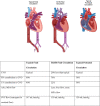Integration of Prenatal Cardiovascular Magnetic Resonance Imaging in Congenital Heart Disease
- PMID: 37982254
- PMCID: PMC10727279
- DOI: 10.1161/JAHA.123.030640
Integration of Prenatal Cardiovascular Magnetic Resonance Imaging in Congenital Heart Disease
Abstract
Standard of care echocardiography can have limited diagnostic accuracy in certain cases of fetal congenital heart disease. Prenatal cardiovascular magnetic resonance (CMR) imaging has potential to provide additional anatomic imaging information, including excellent soft tissue images in multiple planes, improving prenatal diagnostics and in utero hemodynamic assessment. We conducted a literature review of fetal CMR, including its development and implementation into clinical practice, and compiled and analyzed the results. Our findings included the fact that technological and innovative approaches are required to overcome some of the challenges in fetal CMR, in part due to the dynamic nature of the fetal heart. A number of reconstruction algorithms and cardiac gating strategies have been developed over time to improve fetal CMR image quality, allowing unique investigations into fetal hemodynamics, oxygenation, and growth. Studies demonstrate that incorporating CMR in the prenatal arena influences postnatal clinical management. With further refinement and experience, fetal CMR in congenital heart disease continues to evolve and demonstrate ongoing potential as a complementary imaging modality to fetal echocardiography in the care of these patients.
Keywords: cardiac magnetic resonance imaging; congenital heart disease; fetal cardiac gating; pregnancy.
Figures


References
-
- Schneider PD, Groner A. Understanding the limitations of fetal cardiac imaging. NeoReviews. 2018;19:e134–e142. doi: 10.1542/neo.19-3-e134 - DOI

